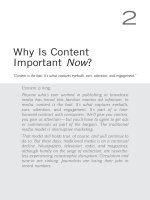Content marketing think like a publisher chapter 8 content curation and aggregation
Bạn đang xem bản rút gọn của tài liệu. Xem và tải ngay bản đầy đủ của tài liệu tại đây (553.1 KB, 8 trang )
8
Content Curation and
Aggregation
What’s the biggest problem marketers say they face when
it comes to content marketing? Producing original content
is the number one issue (73.6%), followed closely by finding the time to produce content (73.0%), according to the
findings of a 2011 survey conducted by HiveFire (see
Figure 8.1).
A study of business-to-business marketers conducted the
previous year by Junta42 and MarketingProfs had similar
findings (see Figure 8.2).
Small wonder. Consistently creating and publishing original content is a full-time job. It takes time, thought, and
resources. That’s why nearly half of marketing executives
(48%) are using content curation according to a 2011 survey from HiveFire. And many more are aggregating content to publish on their blogs and websites and in social
media outlets. As is shown in Figure 8.3, they’re doing it
to establish thought leadership (78.9%), to elevate brand
visibility and generate buzz (76.1%), and encourage lead
generation (60.6%).
Part II
48
W h a t K i n d o f C o n t e n t A r e Yo u ?
What are your content marketing challenges?
80.0%
70.0%
60.0%
50.0%
40.0%
73.0%
73.6%
30.0%
20.0%
43.0%
39.2%
36.5%
10.0%
18.9%
12.8%
0.0%
Finding high
quality
content
Creating
original
content
Having the
time to
do it
Allocating
staff to
do it
Securing Understanding Difficulty
senior-level
how it fits
measuring
buy in to
into overall
results
implement it marketing
strategy
Figure 8.1 Overwhelmingly, marketers say creating original content—and finding the
time to do it—is their biggest challenge when it comes to content marketing.
9%
Producing a
Variety of Content
11%
Lack of
C-Level Buy-In
Biggest Content Marketing
Challenge
3%
No Answer
Producing Engaging Content...........36%
36%
Producing
Engaging Content
20%
Budget to
Product
Content
Producing Enough Content..............21%
Budget to Produce Content..............20%
Lack of C-Level Buy-In.....................11%
Producing a Variety of Content..........9%
21%
Producing
Enough Content
No Answer..........................................3%
Figure 8.2 To their credit, marketers don't just want to publish content for content's
sake. They want it to resonate with their audience, which is no mean feat.
Content curation and aggregation can be defined as a highly proactive and selective
approach to finding, collecting, organizing, presenting, sharing, and displaying digital content around predefined sets of criteria and subject matter to appeal to a
Chapter 8
Content Curation and Aggregation
49
target audience. It’s become essential not only to marketing and branding, but to
journalism, reporting, and social media—often, it’s a mashup of all these different
and disparate channels.
What are your main objectives of content curation?
90.0%
80.0%
70.0%
60.0%
50.0%
40.0%
78.9%
76.1%
73.6%
30.0%
20.0%
60.6%
47.9%
10.0%
0.0%
Boost SEO
Establish thought
leadership
Elevate brand
visibility and buzz
Lead generation
Figure 8.3 Research indicates there is a solid understanding of the benefits of strong
content marketing: credibility, buzz, lead-generation, and search visibility.
Why bother? Tons of reasons. It’s a big, big web
out there. There are literally billions of sites, millions of blogs, and more video being uploaded per
minute to YouTube and tweets being tweeted than
you could watch or read in a lifetime. The problem isn’t enough content. It’s knowing what content actually merits time and attention.
“The problem
isn’t enough
content. It’s
knowing what
content actually
merits time and
attention.”
More and more, people rely on trusted sources—
friends, family, brands, companies, experts, you
name it—to keep them informed, educated, and
even amused. Just as you probably have one go-to
friend for car advice, another who can tell you
what new books or films are worth seeing, or
another who’s got the lowdown on the latest places to eat, business are collecting,
organizing, and filtering content around their own fields of expertise.
50
Part II
W h a t K i n d o f C o n t e n t A r e Yo u ?
Take bOINGbOING.net, one of the web’s most popular blogs. Its traffic often
exceeds that of NYTimes.com. The group blog is nothing more (or less) than
curated content—items its contributors, and often its readers, find and share with
others.
Content curation and aggregation can take many forms: feeds, “channels” (such as
on YouTube), blogs, or even the links you upload to social media sites such as
Facebook. It can be an online newsroom, a collection of links, an assortment of RSS
feeds, or a Twitter list. Whatever form content curation does take, it’s around a
topic, a subject, or even a sensibility that speaks to the knowledge, expertise, taste,
refinement, brand message, or persona of the person, brand, or company that has
created the particular content channel.
Content channels can be as subject-specific as bee-keeping equipment or as amorphous as “what’s cool.” But they all serve multiple purposes, ranging from informing
to engaging to entertaining. In an era where marketing is supplanting advertising
and storytelling is an ever-more essential part of the marketing message, carefully
curated content—well organized and presented—is an immense brand asset, be it to
a humble, over-caffeinated individual blogger or a Fortune 100 company.
Curation and aggregation needn’t be merely collecting and cataloging a bunch of links,
abstracts, and headlines, of course. There’s nothing wrong with writing up a brief paragraph or two putting your own spin on an external article or story, or blending outside
content with your own original contributions. Pawan Deshpande, CEO of HiveFire, a
company that makes a content curation tool, suggests a mix of perhaps 1 original piece
per week plus 12 curated items of content. Your own mileage, of course, may vary.
Examples
Plenty of websites thrive with little to no original content. Google is a prime example. Search engines aggregate content from across the web; they publish little of
their own. Travel sites such as Expedia and Kayak aggregate feeds from hundreds of
hotels and airlines. Techmeme aggregates technology stories from across the web
into one authoritative collection.
Of course, you can also apply this model to marketing. Purina’s Pet Charts aggregates pet-related content from across the web (see Figure 8.4). GE’s EcoPressed
does the same thing with ecologically minded content, and Green Data News from
Verne Global does much the same thing, but with a computer technology bent.
Adobe’s CMO.com is a collection of marketing stories and news targeted to this
critical component of the company’s target audience.
3M has a widget on its career page that contains articles highlighting the company’s
innovations and achievements, making it appear a more attractive place to work for
job seekers. The tactic has also been embraced by the nonprofit sectors.
Chapter 8
Content Curation and Aggregation
51
Organizations such as the Economic Development Council of Western
Massachusetts have sites featuring content about business and economic growth in
their region.
Of course, not all quality content is “out there.” Many quality publications you
might want to link to have content behind a paywall, such as with The Wall Street
Journal or The New York Times. HiveFire CEO Pawan Deshpande doesn’t see this as
a significant barrier to publishing headlines, abstracts, or links to those pages. “We
do have customers for whom almost all the content they aggregate is behind a paywall,” he said, “Really, all they need to do is publish the abstract. Most of their
clients have access to the full article.”
Figure 8.4 Purina Pet Charts gathers pet-related content from around the world and
places it in one spot for pet lovers.
Curated content does more than augment websites, blogs, or social media channels. It
can also be a great tactic to keep email newsletters interesting and relevant. The
curated content you’re using in online channels can be flowed into newsletters. Many
marketers opt into services such as SmartBrief.com, a company that creates subjectspecific newsletters created entirely of aggregated content. Their clients run the gamut
and include thousands of B2B organizations and professional trade associations.
Finding Content
Curating and aggregating third-party content obviously requires less commitment
on the creation side than does conjuring a steady stream of original content.
Nevertheless, there’s still a commitment of time, resources, and setting up procedures to mine and sift through sources.
52
Part II
W h a t K i n d o f C o n t e n t A r e Yo u ?
Your first step is obvious: Scour the media and the Internet for topics of interest:
• Set up RSS feeds for keywords and phrases to automate delivery of web content from blogs, newswires, and news stories that is potentially of interest.
• Read relevant trade publications, newspapers, and magazines.
• Subscribe to trade organizations’ and competitors’ publications to spark
new ideas.
• Attend trade shows and conferences. Conference programmers are
tasked with keeping current on industry trends and issues. Aside
from conversations and learnings gleaned at these events, just
keeping an eye on agendas can be a big tip-off.
• Gather research and data, such as surveys, statistics, and reports.
Mine numbers not only for potential sources of written content but
also for visual ones: charts, graphs, and infographics.
• Don’t discount the mainstream news. Consider how larger stories
might impact your own niche or vertical. The tragic, triple disaster of
earthquake, tsunami, and nuclear catastrophe that struck Japan in
2011 could, for example, be a point of departure for content on a myriad of issues: disaster preparedness, construction, building inspection,
insurance, energy policy, alternate power sources, emergency medical
services, grief counseling, homelessness, and search and rescue. The
list goes on and on, and each of these cited topics is rife with
subtopics that might be relevant to a business’s core competencies.
Finding the relevant coverage and briefly adding a point of view or
explanation of a relevant angle to your own target audience is a perfectly legitimate form of content curation.
Don’t Be a Pirate
It should go without saying (but alas, too often it does not) that curating and aggregating content comes with a set of obligations—ethical and moral, as well as legal.
Respect copyright. Most editorial sites have published guidelines regarding the
reuse of their content. In most (but certainly not all) cases, this can be summarized
as allowing third parties to link to the full story or item with a headline and brief
descriptive blurb or a quote of reasonable length. Most publishers are happy for the
link. It increases both their traffic and their search engine visibility.
Other sites have more liberal or more restrictive policies. When in doubt, ask.
Shoot over an email explaining what you’d like to use and why (supplying any necessary links to the site or channel). With websites getting the bulk of their traffic
Chapter 8
Content Curation and Aggregation
53
these days from third-party sites such as Facebook and Twitter, publishers are really
beginning to understand the value of such referrals, and linking to content legally is
much easier than it was in the days before social media when many publishers
thought proprietary was the way to go.
Aggregation, Filtering, and Curation Platforms
Content aggregation and curation is only emerging as far as technology solutions
are concerned. Some are newsletter specific, whereas others are aimed at communities or hyperlocal markets. Some emphasize SEO, whereas others lean on social filtering. Some work on your sites, whereas others create content sites on their own
platforms. There are no cookie-cutter solutions, but there are technologies that help
publishers and marketers aggregate, filter, curate, and publish content.
Here’s a list of some commercial solutions:
• Aggreage—Creates topic-centered sites around specific market segments
• CIThread—Helps editors curate content for online communities
• Curata—HiveFire’s content curation and distribution platform
• CurationStation—Web-based software service offering a tool kit for
gathering/monitoring, selecting, and sharing specific items among
dynamic content
• DayLife—Publisher platform that consolidates media sourcing, management, curation, and composition
• Eqentia—Enterprise platform for aggregating, curating, consuming,
analyzing, and republishing news content
• idio—Platform for aggregation and publishing using semantic extraction and other analytics approaches
• Loud3r—A real-time content discovery, curation and publishing platform
• MainStreetConnect—Creates independent hyperlocal news publications
• OneSpot—Aggregates, filters, and prioritizes content
• Outside.in—Hyperlocal content solutions for sites and apps
• Perfect Market—Helps publishers identify, package, distribute, and
monetize content
• Publish2—Content acquisition and workflow optimization
54
Part II
W h a t K i n d o f C o n t e n t A r e Yo u ?
• PublishThis—On-demand content publishing platform for discovery,
collection, and delivery of relevant, real-time content; provides audience segmentation capabilities
• SmartBrief—Industry- or topic-specific email newsletters









